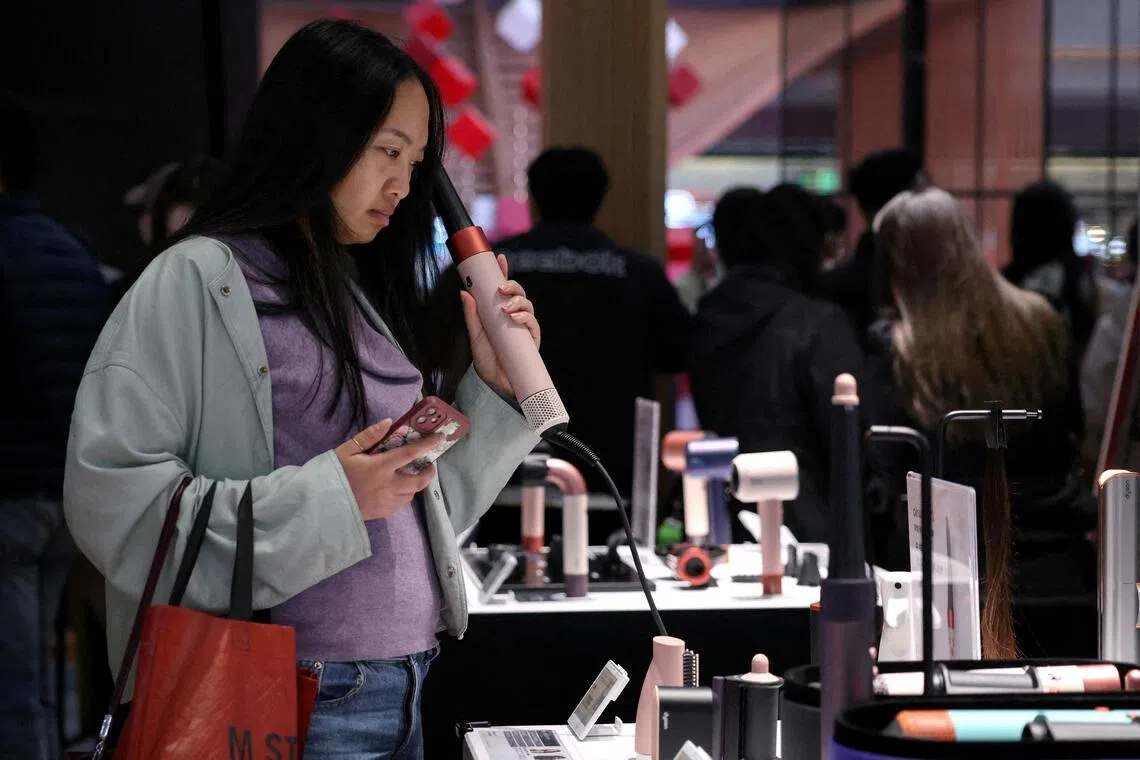China’s consumers are in a years-long funk, will anything get them to spend?
Sign up now: Get insights on Asia's fast-moving developments

A customer tries a hair straightener at a home appliance mall in Beijing, China, on Oct 19.
PHOTO: REUTERS
Alexandra Stevenson
Follow topic:
SHANGHAI – Shoppers all over the world are buying more stuff from China than ever before. Even Americans are, despite the rising cost of tariffs.
The only people who aren’t, it seems, are those in China.
That is at the heart of a very big problem for China’s top leadership as it tries to steer a weakening economy through the volatility of the trade war with the United States. China depends on the world’s consumers to keep its economy steady, a point that was made clear on Oct 20 by its latest economic update.
China is on track in 2025 to export US$1 trillion (S$1.3 trillion) more than it imports. That massive imbalance, and the country’s reliance on exports, complicates China’s position as its top leader Xi Jinping is expected to talk with President Donald Trump next week. It is a growing concern for Mr Trump, and officials around the world are insisting that China rebalance its economy more toward domestic consumer spending.
Top Chinese officials are meeting this week to plot the country’s policies for the next five years. They are contending with a handful of challenges at home, including youth unemployment, a threadbare social welfare system and an ageing population. The government has failed to take on these problems aggressively, instead tinkering with incremental policy changes and doubling down on investing in the factories that generate goods for export.
Yet tackling these issues could go a long way toward getting to the root of the problem for consumers like Ms Chen Yiling, a mother of two.
“I think the current economic climate is too bad,” Ms Chen, 35, said as she browsed knickknacks with her 3-year-old daughter at a mall on the outskirts of Shanghai. “It’s hard for anyone to find a job, and even if they do, they’re easily fired.” Her husband works in finance but does not have a permanent job. The family is living off savings.
Economists have traced that kind of pessimism to the Covid-19 pandemic and China’s sudden lockdowns of neighborhoods and cities. Officials thought that a reversal of those policies at the end of 2022 would release pent-up demand and set off a spurt of “revenge spending”, as other countries had experienced.
It never came.
Unlike many national governments that handed out money to families during the pandemic, Beijing never put cash in people’s pockets. Households generally have less income today than they did before the pandemic, and they are dealing with rising health care costs. Chinese companies were also left to fend for themselves, and many cut back on pay and started letting employees go.
A crash in housing prices that began in 2021 has also weighed heavily in a country where people sank their savings into real estate.
Ms Chen owns four apartments, three of which are occupied by her family. The other is rented out, but her tenant is asking her to lower the rent.
“Many people are giving up their leases,” she said. “Rents aren’t as high as they were in previous years, so everyone’s looking to lower their rents.”
To rev up the economy, Beijing started a consumer trade-in campaign in 2024 for people to exchange their old household appliances and cars for cheaper new ones. This year it added smartphones and other electronics.
That led to a burst of spending activity, but that is now waning. Dr Lu Ting, the chief China economist for Nomura, the Japanese bank, is worried that if the programme is extended for another year, it could begin to hurt companies that are slashing their prices to attract buyers.
For the government to get consumers to feel confident to spend more, it will have to fix its pension system, which offers an average of US$1 a day in retirement for more than half of China’s retired population.
“This is really a problem that I strongly believe is at the core of China’s consumption,” Dr Lu said. “If you don’t want to fall into poverty when you retire, then you have to save.”
Many people who have lost their jobs in recent years, or who have graduated without employment prospects, have turned to delivering food or packages. The gig economy employs more than 200 million people in jobs that have traditionally been insecure with limited benefits and often no social insurance.
The government has started funneling money to young couples to encourage them to have babies, but middle-age women who once helped to power a consumer boom are now faced with rising costs of aging parents and their own children.
On a recent weekday, Ms Huang Weijia, 45, and Ms Jenny Wu, 42, were on a break from work at a community care clinic nearby. They shared a conversation and an ice cream inside a mall in the eastern city of Jiaxing. Both said that their salaries as doctors, about US$1,400 a month, had decreased slightly, but that they felt relatively safe because they had government jobs.
“My spending is higher at this stage, so it feels like expenses are particularly high, and it feels like I can’t save much,” said Ms Wu, who has two teenagers and spends as much as US$7,000 a year on each of their extracurricular studies.
Ms Huang chimed in, referring to her generation: “I think we’re the biggest spenders right now.” She also has two teenagers, and she estimated that she spent similar to what Wu did on each of her children.
“Our parents are also getting older now, and they’re getting sick more often,” Ms Huang said. “I used to think I could save while spending, but now I feel like I can’t.” NYTIMES

